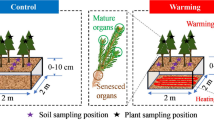Abstract
Aqueous leachates derived from canopy phyllodes of invasiveAcacia cyclops affected growth of a range of shrub species independently of nutrient input effects. All plants showed a sublethal phytotoxic response. Root mass was generally less adversely affected than shoot mass and, while decreasing significantly in response to the 10% concentration, showed no such response to the 1% solution. Root-shoot biomass ratios increased, except inEuphorbia burmannii, which may recognize intrinsic root architecture limitations on extensive exploitation of toxin-free soil. Application of surface plant litter from underA. cyclops canopies stimulated the production of basal stems inProtasparagus capensis andEriocephalus racemosus but was insufficient to significantly reduce root-shoot ratios. Plant growth inhibition was maximized by canopy leachate compounded by surface litter effects inAnthospermum spathulatum. The net effect of leachate at high concentration on biomass allocation in certain shrub species may help explain their patterns of association and disassociation withA. cyclops.
Similar content being viewed by others
References
Achhireddy, N.R., Singh, M., Achhireddy, L.L., Nigg, H.N., andNagy, S. 1985. Isolation and partial characterization of phytotoxic compounds from Lantana (Lantana camara L.).J. Chem. Ecol. 11:979–988.
Buta, J.G. andSpaulding, D.W.. 1989. Allelochemicals in tall fescue—abscisic and phenolic acids.J. Chem. Ecol. 15:1629–1636.
Harborne, J.B. 1988. Introduction to Ecological Biochemistry. Academic Press, London.
Harper, J.L. 1975. Allelopathy (a review).Q. Rev. Biol. 50:493–495.
Hegazy, A.K., Mansour, K.S. andAbdel-Hady, N.F. 1990. Allelopathic and autotoxic effects ofAnastatica hierochuntica L.J. Chem. Ecol. 16:2183–2193.
Heisey, R.M. 1990. Evidence for allelopathy by tree-of-heaven (Ailanthus altissima).J. Chem. Ecol. 16:2039–2055.
Hewitt, E.J. andSmith, T.A. 1975. Plant Mineral Nutrition. English Universities Press Ltd., London.
Keeley, J.E. andKeeley, S.C. 1989. Allelopathy and the fire-induced herb cycle, pp. 65–72,in S.C. Keeley (ed.). The California Chaparral. Paradigms Reexamined. No. 34 Science Series, Natural History Museum of Los Angeles County, Los Angeles.
Kil, B.-S. andYun, K.W.. 1992. Allelopathic effects of water extracts ofArtemisia princeps var.orientalis on selected plant species.J. Chem. Ecol. 18:39–51.
Leather, G.R. andEinhellig, F.A. 1988. Bioassay of naturally occurring allelochemicals for phytotoxicity.J. Chem. Ecol. 14:1821–1828.
Lovett, J.V., Ryuntyu, M.Y. andLiu, D.L. 1989. Allelopathy, chemical communication, and plant defence.J. Chem. Ecol. 15:1193–1202.
Lyu, S.-W. andBlum, U. 1990. Effects of ferulic acid, an allelopathic compound, on net P, K, and water uptake by cucumber seedlings in a split-root system.J. Chem. Ecol. 16:2429–2439.
Macdonald, I.A.W., Kruger, F.J. andFerrar, A.A. (eds.) 1986. The Ecology and Management of Biological Invasions in Southern Africa. Oxford University Press, Cape Town.
Martin, V.L., McCoy, E.L. andDick, W.A. 1990. Allelopathy of crop residues influences corn seed germination and early growth.Argon. J. 82:555–560.
May, F.E. andAsh, J.E. 1990. An assessment of the allelopathic potential ofEucalyptus.Aust. J. Bot. 38:245–254.
Molina, A., Reigosa, M.J. andCarballeira, A. 1991. Release of allelochemical agents from litter, throughfall, and topsoil in plantations ofEucalyptus globulus Labill in Spain.J. Chem. Ecol. 17:147–160.
Mooney, H.A., Kummerow, J., Moll, E.J., Orshan, G., Rutherford, M.C. andSommerville, J.E.M. 1983. Plant form and function in relation to nutrient gradients, pp. 55–76,in J.A. Day (ed.). Mineral nutrients in mediterranean ecosystems. South African National Science Programmes Rep. 71. Council for Scientific and Industrial Research, Pretoria.
Qasem, J.R. andHill, T.A. 1989a. On difficulties with allelopathy methodology.Weed Res. 29:345–347.
Qasem, J.R. andHill, T.A. 1989b. Possible rôle of allelopathy in the competition between tomato,Senecio vulgaris L. andChenopodiun album L.Weed Res. 29:349–356.
Rice, E.L. 1984. Allelopathy, 2nd ed. Academic Press, Orlando, Florida.
Rice, E.L. 1986. Allelopathic growth stimulation, pp. 23–42,in A.R. Putnam and C.-S. Tang (eds.). The Science of Allelopathy. John Wiley & Sons, New York.
Richardson, D.R. andWilliamson, G.B. 1988. Allelopathic effects of shrubs of the sand pine scrub on pines and grasses of the sandhills.For. Sci. 34:592–605.
Rutherford, M.C. andBösenberg, J. de W. 1988. Some responses of indigenous western Cape vegetation to the Australian invasive,Acacia cyclops, pp. 631–636,in F. di Castri, Ch. Floret, S. Rambal, and J. Roy (eds.). Time Scales and Water Stress. International Union of Biological Sciences, Paris.
Saville, D.J. 1990. Multiple comparison procedures: The practical solution.Am. Stat. 44:174–180.
Singh, M., Tamma, R.V. andNigg, H.N. 1989. HPLC identification of allelopathic compounds fromLantana camara.J. Chem. Ecol. 15:81–89.
Tang, C.-S. 1986. Continuous trapping techniques for the study of allelochemicals from higher plants, pp. 113–131,in A.R. Putnam and C.-S. Tang (eds.). The Science of Allelopathy. John Wiley & Sons, New York.
Tukey, H.B., Jr. 1970. The leaching of substances from plants.Annu. Rev. Plant Physiol. 21:305–324.
Whitfield, F.B., Shea, S.R., Gillen, K.J. andShaw, K.J. 1981. Volatile components from the roots ofAcacia pulchella R.Br. and their effect onPhytophthora cinnamomi Rands.Aust. J. Bot. 29:195–208.
Williamson, G.B. 1990. Allelopathy, Koch's postulates, and the neck riddle, pp. 143–162,in J.B. Grace and D. Tilman (eds.). Perspectives on Plant Competition. Academic Press, San Diego.
Williamson, G.B., Fischer, N.H., Richardson, D.R. andDe La Pena, A. 1989. Chemical inhibition of fire-prone grasses by fire-sensitive shrub,Conradina canescens.J. Chem. Ecol. 15:1567–1577.
Author information
Authors and Affiliations
Rights and permissions
About this article
Cite this article
Rutherford, M.C., Powrie, L.W. Allelochemic control of biomass allocation in interacting shrub species. J Chem Ecol 19, 893–906 (1993). https://doi.org/10.1007/BF00992526
Received:
Accepted:
Issue Date:
DOI: https://doi.org/10.1007/BF00992526




